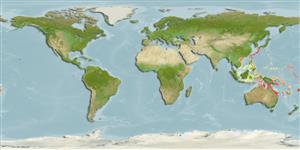Environment: milieu / climate zone / depth range / distribution range
Ecología
marino asociado a arrecife; rango de profundidad 1 - 20 m (Ref. 9710), usually 10 - 20 m (Ref. 9710). Tropical
Western Central Pacific: endemic to Queensland, Australia.
Tamaño / Peso / Age
Maturity: Lm ? range ? - ? cm
Max length : 15.0 cm TL macho / no sexado; (Ref. 9710)
Espinas dorsales (total): 3; Radios blandos dorsales (total): 32-37; Espinas anales 3; Radios blandos anales: 18 - 21. Color variable depending on sex; male mainly red anteriorly and purplish posteriorly; dorsal, anal and caudal fins bluish except dorsal reddish on anterior part; female with a grayish head, largely yellow-orange on side, with 5-6 brown bars on upper half of anterior part of body; fins largely reddish (Ref. 2334).
Usually found in or near holes of coral reefs (Ref. 9710). Minimum depth from https://www.reeflifesurvey.com/species/ogilbyina-queenslandiae/.
Life cycle and mating behavior
Madurez | Reproducción | Puesta | Huevos | Fecundidad | Larva
Bi-directional sex change has been proposed for this species though histological analysis of more specimens is needed for confirmation (Ref. 103751).
Paxton, J.R., D.F. Hoese, G.R. Allen and J.E. Hanley, 1989. Pisces. Petromyzontidae to Carangidae. Zoological Catalogue of Australia, Vol. 7. Australian Government Publishing Service, Canberra, 665 p. (Ref. 7300)
IUCN Red List Status (Ref. 130435)
Threat to humans
Harmless
Human uses
Acuario: Comercial
Más información
ReferenciasAcuiculturaPerfil de acuiculturaRazasGenéticaElectrophoresesheritabilidadEnfermedadesProcesamientoNutrientsMass conversion
ColaboradoresImágenesStamps, Coins Misc.SonidosCiguateraVelocidadTipo de nataciónSuperficie branquialOtolitosCerebrosVisión
Herramientas
Special reports
Download XML
Fuentes de Internet
Estimates based on models
Preferred temperature (Ref.
123201): 24.6 - 27.9, mean 26.6 °C (based on 72 cells).
Phylogenetic diversity index (Ref.
82804): PD
50 = 0.6250 [Uniqueness, from 0.5 = low to 2.0 = high].
Bayesian length-weight: a=0.01148 (0.00439 - 0.03002), b=3.01 (2.78 - 3.24), in cm total length, based on LWR estimates for this (Sub)family-body shape (Ref.
93245).
Nivel trófico (Ref.
69278): 3.8 ±0.5 se; based on size and trophs of closest relatives
Resiliencia (Ref.
120179): Alto, población duplicada en un tiempo mínimo inferior a 15 meses (Preliminary K or Fecundity.).
Fishing Vulnerability (Ref.
59153): Low vulnerability (10 of 100).
Nutrients (Ref.
124155): Calcium = 87 [53, 142] mg/100g; Iron = 0.697 [0.447, 1.099] mg/100g; Protein = 19.1 [18.1, 20.0] %; Omega3 = 0.152 [0.100, 0.226] g/100g; Selenium = 21.1 [12.6, 36.7] μg/100g; VitaminA = 137 [52, 358] μg/100g; Zinc = 1.57 [1.12, 2.13] mg/100g (wet weight);
